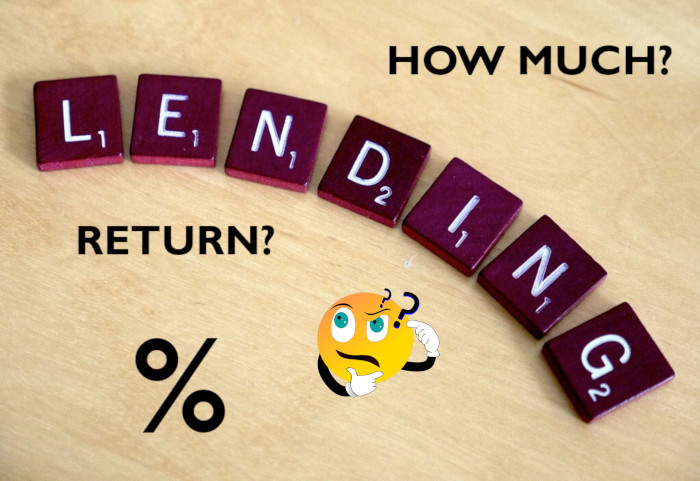So, you’ve got some capital to invest, and you’ve decided you might like to start lending with P2P lending sites as part of a diversified investment strategy?
Where do you start? Which are the P2P lending companies that offer the best Peer to Peer Lending? Is safety your number one concern? Or is it making as much return as you can, and you’re willing to take more risk in order to do that? That is the first thing you need to decide.

Personally, I lean more towards taking a little less risk for a little less income. The reason being, if I were to have one big loss, it could easily wipe out a year or more of income. Plus I like to sleep at night.
The next thing you need to decide is what type of P2P lending you are going to do. Do you prefer to lend to property developers like Assetz Capital, Kufflink or CrowdProperty with the real estate as collateral? Or do you prefer consumer Peer to Peer lending where you’re lending to individuals like Lending Works or Zopa instead of businesses?
How about pawn shop type loans from Peer to Peer lending companies like Unbolted where you have fast disposable assets in the event of defaults? Or do you prefer Peer to Peer lending sites like Ablrate and the glamor of lending on things like private jets or yachts?

Perhaps you’re heavily green & in to saving the planet so you would prefer P2P lending on things that portray a “greener” image like solar power generating stations or P2P lending to consumers who want to purchase electric vehicles? The Euro Peer to Peer lending site Crowdestor does a lot of loans like that.
My personal strategy (which you’ll be aware of if you’ve spent any time reading the Obvious Investor website) is to heavily diversify. So I choose all of the above, and more. I like to have a little bit in everything to dissipate risk.
How about location & currencies? The UK Peer to Peer investing sites are by far the safest in my opinion, providing they are regulated by the FCA of course, but they offer less returns. We just went through the COVID pandemic. When it hit, I had over £220k invested in UK Peer to Peer lending sites (and another €100k in Euro P2P lending platforms). Even though several of the UK Peer to Peer lending companies went out of business, or stopped lending to retail. I didn’t lose a penny all through the pandemic.
Euro Peer to Peer lending sites on the other hand, not quite as solid. The Envestio P2P platform owners decided to make up fake loans and run off with investors money (we all filed a class action law suit and they have already seized some assets so we should get some money back). Then there were a couple of LO’s (Loan Operators) on Mintos (the largest European P2P platform) who ended up going out of business because they weren’t getting paid by borrowers. Buyback guarantees were not able to be honored, so investors had to take a haircut there. When you’re investing in 15% or 20% return loans with unregulated Peer to Peer lending sites, you’d better expect some losses.
All that being said, these Euro P2P lending platforms were (and generally still are) higher risk P2P lending platforms. Some paying upwards of 25% returns on loans. So risk was expected to be much higher than say one of the best Peer to Peer lending companies like Loanpad in the UK, who pay 4%, but are extremely safe in my opinion. The Euro lenders that I will continue to invest in are Crowdestor, Mintos (although I will choose LO’s carefully), Swaper, Peerberry & Robocash all of whom came through COVID, returned investors capital, and generally did what they were supposed to do. In my opinion, these are some of the best Peer to Peer lending sites in Europe.

The next step of course is choosing which particular P2P lending platforms you need to lend with. This is mostly what the remainder of this document is about. At the end I wrote a little blurb about my first experiences with Peer to Peer lending companies, including a cautionary tale about an initial scare. Not necessary to read in order to get started, but you might find it interesting.
- How to Choose The Best Peer to Peer Lending Sites
- 10 Rules of Peer to Peer Investing
- 1 . Consider Safety Before Chasing High Returns
- 2. Get to Know the P2P Lending Company Behind the Platform
- 3. Get to Know the Team Behind the P2P Lending Platform
- 4. Is the P2P Lending Platform FCA Regulated? Or Regulated by Some Others Agency, Depending Where you are Investing?
- 5. Ensure You Understand the P2P Lending Loan Types & Terms Offered
- 6. Take Note of How Deposits & Withdrawals Work, and How Capital is Held by the P2P Lending Company.
- 7. Diversify, Diversify, Diversify! – Spread that Capital About!
- 8. Use the Well Established, Best Peer to Peer Lending Sites First
- 9. Don't Be A Fool Rushing In!
- 10. Become an Expert in P2P Lending! (or Don't?)
- 10 Rules of Peer to Peer Investing
- Other General Information on Peer to Peer Lending
- Potential Returns, Tax Free Lending (ISA/IFISA) & Moving Money
- Potential Return on Peer to Peer Lending
- Tax Free Lending (for UK Residents)
- Innovative Finance Individual Savings Account (IFISA) & Tax Free Peer to Peer Lending in the U.K.
- Moving Money Between Platforms
- Move Capital Between the best Peer to Peer Lending sites as Needed
- Summary
- A Bit of History on How I Got Started in Peer to Peer Lending
How to Choose The Best Peer to Peer Lending Sites
10 Rules of Peer to Peer Investing
1 . Consider Safety Before Chasing High Returns

It’s easy to get excited about P2P lending companies offering 15% – 25% or more returns on your hard earned capital. Remember this if nothing else; the level of risk you are taking is always relative to the rewards you can receive. If a borrower is paying upwards of 30% interest to the platform, they are paying that because they can’t get the loan cheaper from elsewhere. There is usually a reason for that.
Look at the P2P lending platforms, how stable are they? Look at the types of loans; secured? unsecured? Who are they P2P lending to? Businesses? Consumers? is the company behind the Peer to Peer lending site profitable? How long have they been in business? It can take some effort to find the best Peer to Peer lending sites.
Getting 25% per annum return on 10k sounds wonderful, however 7% and being comfortable that you can get your capital back when you need it makes more sense. Being able to sleep at night also counts for something. The best P2P lending companies will not keep you awake at night worrying about your investments.
2. Get to Know the P2P Lending Company Behind the Platform

Although it’s not the end of the world if a P2P lending company goes broke, because with most of the best Peer to Peer lending companies, the loans are directly between you and the borrower. The Peer to Peer lending site is just an administrator and facilitator. However, if the P2P lending company does cease trading, it’s going to cause you some major headaches at best.
Who’s going to service the loans to make sure you get your money back? How about collections when a borrower defaults? If the P2P loans are asset secured, who’s going to sell that development property, car or boat so they can retrieve your capital?
Before you place your money with any of the P2P lending companies, call them. Ask to speak to the Managing Director or CEO. You may be surprised to find that most of them will be happy to speak with you. Remember, you are the P2P investor, and they are vying for your money, because that’s how they make money.
Ask them all the questions above, and any others you can think of to help you feel comfortable. Go to the website of the entity that regulates them and see what they say. Don’t send any money until you’re comfortable that they are going to take care of it for you, and act professionally on your behalf.
Note that FCA regulated Peer to Peer lending sites must have a wind down plan in place, and filed with the FCA in case they were to go out of business. You can ask to see that which will tell you exactly what will happen if the unfortunate event takes place.
3. Get to Know the Team Behind the P2P Lending Platform

Do they have experience lending money? Did they come from a banking background or some other area where they understand how everything works?
Do they have a history of collecting on bad debt? You’ll find that many of the more established P2P lending companies have decades of experience in these areas, from high level management to the book keepers & admin staff.
When Loanpad started up, they obviously had no history whatsoever in the P2P lending space. I invested with them anyway. Why? Because their CEO Louis Schwartz was an experienced property lawyer with many years in the business.
The rest of the team all came from banking or development lending backgrounds. Time has proved they know what they are doing. I think they are about the safest & one of the best Peer to Peer lending sites out there right now.
4. Is the P2P Lending Platform FCA Regulated? Or Regulated by Some Others Agency, Depending Where you are Investing?

The safest & best Peer to Peer lending companies are FCA (Financial Conduct Authority) regulated in my opinion. The FCA is a financial regulatory body in the United Kingdom. It operates independently of the UK Government, and is financed by charging fees to members of the financial services industry. The FCA regulates financial firms providing services to consumers and maintains the integrity of the financial markets in the United Kingdom.
P2P Lending through firms that are regulated by the FCA (or some other agency) just gives you another layer of security. It does not mean you can’t lose your money through loan defaults, however it means that fraud or serious mistakes by the P2P lending platform is much less likely.
FCA regulated P2P lending companies have to adhere to certain standards and levels of transparency. They also have to have wind-down plans in place to ensure investors get their money back in case they go out of business.
5. Ensure You Understand the P2P Lending Loan Types & Terms Offered

Ensure you understand exactly the loan types and terms of the loans you are going to be investing in. Who will you be P2P lending to? Is there any asset security? What is the Loan to Value (LTV) if so?
When default happens, how easy will those assets be to sell? Gold, silver or pawn shop items may sell faster than a multi-million pound office block, or a G6 private jet.
Are the P2P loans covered by a “provision fund” or “buyback guarantee” that reimburses you if the loans go bad so you can get your capital back faster.
Does the P2P lending platform have “skin in the game“, meaning do they invest a percentage of their own money in the loan? Is their investment on a “first loss” bases, where they cover the first amount of any capital lost? How long are the loan terms? Is it possible to exit the loans early in normal market conditions in the case you need your capital back quickly? Understand everything, in detail!
6. Take Note of How Deposits & Withdrawals Work, and How Capital is Held by the P2P Lending Company.

Make sure you are clear on the rules each P2P lending platform has about deposits, and withdrawing funds. On my reviews I list all of this information as I understand it, so study them before signing up with a new lender.
Ask questions of the P2P lending platform if you are unsure of anything. How quickly can your money be lent out based on the amount you are going to invest with them? Where does it sit while it’s not on loan? Do they pay interest while money is not on loan? How long will it take to withdraw if you need it in an emergency? Not just exiting loans early, but actually getting your capital out and into your hands.
The best peer to peer lending companies may even have a cheat sheet for you with answer on all of the above.
Cautionary Story, about not paying attention……

When I first started investing in P2P lending, I had read some great reviews on a relativity new lender. How great they were, supposedly the best Peer to Peer lending site. They were offering some huge returns on secured loans. I did a little research and everything I was reading on review sites seemed accurate.
So I decided I wanted to get in right away to get some of these high-return P2P lending loans for myself. I signed up for an account, and found they would accept capital instantly by debit card. So I quickly deposited an amount of capital with them. No time to waste getting that high yield return.
Over the next month or so, I noticed that only 4% – 5% of the capital had actually been loaned out. I eventually came to understand that indeed, most of the reviews I had read were honest and fairly accurate, however what wasn’t clear is that these reviews were from people who either had never invested with this P2P lending platform, or the capital they invested was relativity small compared to what I had sent over to lend (and it really wasn’t THAT much).
These smaller amounts were lent out easily and the investors/reviewers were happy. Unfortunately, after speaking with the company behind the P2P lending platform, it became clear that the larger amount I had deposited to lend was going to take a long time to become fully invested. Diversifying into enough loan pieces was going to be difficult because of the smaller loan book and low new loan flow.
No problems I thought, things happen, my fault for not doing more research, so I decided to withdraw the remainder of my capital and invest it in a larger, more established Peer to Peer lending platform, even with lower returns, it was better than nothing.
When I went to do the transfer out, I then discovered the platform had a policy (for genuine anti-money laundering purposes) in which deposits that were made by debit card could not be withdrawn for 90 days! So I was faced with the prospect of funds sitting there in an account, un-invested, and making absolutely no return for the next 90 days.
It never worried me about losing my capital as the P2P lending platform was genuine, well known and FCA regulated. I had not noticed their policy which, to be fair, was displayed on the debit card deposit page on their website. I just wasn’t paying enough attention, being in a rush to get those huge returns.
Everything worked out in the end, I got every penny back as the platform “bent” their policy for me and eventually agreed to send all of the capital back to my debit card from where it came, but needless to say, I take extra care now when depositing capital with a new platform, so I understand exactly what their policies are about withdrawing capital.
7. Diversify, Diversify, Diversify! – Spread that Capital About!

If you’ve read other parts of the Obvious Investor website, you’ll know I call diversification “the prime directive”. It is especially true with Peer to Peer lending companies. It would be so easy just to put all of your capital in to a large, well established, best Peer to Peer lending companies, and forget about it. Chances are everything would be ok. Remember though that these investments are not bank accounts. Because the industry is relatively new, no one really knows what will happen when the next financial crisis hits.
We can look at banks and how their lending business has fared historically to get an idea of what might happen. However banks tend to be very large organizations with huge capital backing them, and even if they go broke, the government tends to bail them out. We don’t know how that would work with a P2P lending platform though. So make sure you spread your capital over as many legitimate and best Peer to Peer lending companies as you can find. And then spread it over as many P2P lending loans as you can within those lenders. Even if it means accepting lower rates on some of them.
8. Use the Well Established, Best Peer to Peer Lending Sites First

Personally I place more capital with larger, well established P2P lending platforms who publish not only their historical statistics, but also the plans they have for future downturns and recessions (many do publish their “what if” models, ). This information is very useful, not only for us, but for other lenders. They look at this data, as well as P2P lending data from banks & building societies to give us an idea of what to expect when the same type of thing happens in the future, so they can prepare for it as best they can. However I still diversify into other smaller lenders, for piece of mind.
A last note on diversification; In my opinion, even the best Peer to Peer Lending plan should be part of an overall investment strategy. Please don’t place your whole future into any one sector, of any investment type. I suggest only lending money out through Peer to Peer Lending companies that, in the very worst case, you could afford to lose. When I say “afford to lose”, I mean that it wouldn’t change your life significantly if you lost it. The chance of you losing it all is extremely unlikely, but be safe. Please don’t risk being on the streets if the next financial crisis is worse than the last, because no one knows what will happen.
If my P2P lending investments all went south overnight, it would hurt like heck, and cause me a bunch of heartache, but I wouldn’t be on the streets.
9. Don’t Be A Fool Rushing In!

Perhaps you read my cautionary story earlier? These days before I start transferring money to new P2P lending platforms, I typically wait a few days, or at least overnight so I can think about any information I may be missing or not understanding correctly. Don’t be hasty when you decide to invest.
Make sure you are comfortable before depositing money with a new Peer to Peer lending site, think on it for a few days if necessary. If you decide to manually bid on/buy individual loans, as opposed to getting into an auto-invest account, make sure you do your research on each loan, or have a plan to diversify enough so you can take the defaults if you’re loans go south. Take your time, and don’t feel rushed in to bidding until you are sure you want the loan, then go for it and get the best rate!
10. Become an Expert in P2P Lending! (or Don’t?)

Are You a P2P Lending Expert? Or do you want to become one? Can you look at a company’s financial statements and know if they are likely to be in business for the next 5 years so they can pay back your loan? Do you understand what will happen to a consumer if they lose their job? What career they have chosen, and if they are likely to get another job quickly based on that career so they can continue to pay your loan back?
There are large rewards to be had if you really know what you’re doing when lending out money. If you understand asset valuations and whether or not they are reasonable.
If you already have these skills, you can earn a higher return picking out individual loans with the best Peer to Peer lending companies like Assetz Capital, Kuflink or CrowdProperty.
If you’re not an expert, or don’t want to become one, look for well established, respected, and best Peer to Peer lending companies to lend with. Auto Invest is a good option for some. I use it with many of the P2P lending platforms I lend with. Some Peer to Peer lending sites like Loanpad & Lending Works have no other options.
Personally I’m not a P2P lending expert as far as evaluating individual loans. I look for the most well established & best Peer to Peer lenders who have proven they know what they’re doing, then I make sure to diversify between loans. I like to have less than one percent of any account in to any single loan.
Even with Peer to Peer lending companies like Lending Crowd, Kuflink & CrowdProperty, I bid on individual loans, but I don’t really know much about the companies I bid on, except for a quick scan to see how long they’ve been in business, and if they’re making money. Maybe a little Googling to see if they have good reviews and their customers like them. Then I just try to bid a small amount on each loan that looks good to me, so that the distribution will pay a good return after defaults if I’m wrong.
There are expert P2P lending investors out there who make significant returns. If that’s what you’re looking for, you can probably make more return in the long run, but you’ll need to invest your time studying all of the factors I mentioned earlier to become proficient. I can’t help you with that type of investing unfortunately, but I’m happy with the returns I get from my “Lazy Investor” strategy. I maybe spend a couple of hours per month checking on my lending accounts, and that’s only because I publish them here on my website 🙂
That concludes my 10 rules of Peer to Peer investing & finding the best Peer to Peer lending sites. There are many other points to watch of course, but if you stick to the rules when you are starting out, it should put you in a good position to learn about Peer to Peer lending without losing much (if any) capital to investing mistakes
Other General Information on Peer to Peer Lending
Potential Returns, Tax Free Lending (ISA/IFISA) & Moving Money
Potential Return on Peer to Peer Lending

One of the most-asked questions I get from the website is: “How much can I expect to make from P2P lending, really?”.
The answer all depends on how much time you want to invest per the last section above, and how much risk you are willing to take. If I average out all my best Peer to Peer Lending investments, I think between 4% to 7% is a reasonable overall expectation with GBP lenders not taking any unnecessary risks. In Euros it’s possible to easily make 10% – 15%, but they are not as safe as the UK’s best Peer to Peer lending sites, as they are not regulated.
I like to stick with (what I consider to be) the lower risk, low maintenance & best Peer to Peer lending sites for most of my capital. I’m happy with that return in this situation. It sure beats the returns the money was getting sat in a bank before I stared P2P lending, and I sleep at night 🙂
That being said, I do have some high-yielding Euro investments, but I typically don’t put a whole lot of capital in any one Euro P2P lending site. I’ll always identify my perceived risk level of any lender in my reviews.
Tax Free Lending (for UK Residents)
Innovative Finance Individual Savings Account (IFISA) & Tax Free Peer to Peer Lending in the U.K.

I am not a tax professional, so I can’t give tax advice. However it is worth mentioning that many of the established & best Peer to Peer lending companies support tax free accounts such as an ISA/IFISA. P2P lending through an IFISA (Innovative Finance Individual Savings Account) can, for most people, make a lot of sense as it can allow interest to accrue on your investments tax free.
There are some rules however that can affect money in these accounts and how it can be lent. It can also make it more difficult to diversify between the best Peer to Peer lending sites, as some P2P lending companies have a minimum £5000 investment to invest through a Peer to Peer lending IFISA with them. And the maximum investment in any P2P lending IFISA is £20,000. Your personal diversification would depend on which P2P lending sites you chose, and their loan availability and distribution.
One thing to note about IFISA’s and distributing capital across multiple accounts. Many people think you can only open one IFISA or Peer to Peer lending ISA per year. However, as I understand it, we are actually allowed to open as many IFISA’s in one tax year as we like. The rule is that you’re not allowed to put “new money” from the current year into more than one of them. So we can open one £20k IFISA and fund it with new money up to £20k. But then open others and distribute capital already invested in older IFISA’s.
So for example, if you already had IFISA’s with Assetz Capital, you could open a new IFISA’s with Lending Works and fund it with “20k, but you could also open new IFISA’s (in the same tax year) with, Kuflink and Loanpad, then move some money from your Assetz Capital IFISA’s into those new accounts in order to diversify your capital across the best Peer to Peer lending companies. Don’t forget to use the cashback links on my site if you decided to do it as that can make a HUGE difference in the first year’s returns.
Overall, investing through a Peer to Peer lending ISA/IFISA seems to make a lot of sense, however consult your tax professional before you start to lend to be sure it will be the best option for you.
Moving Money Between Platforms
Move Capital Between the best Peer to Peer Lending sites as Needed

Once you have a relationship with a P2P lending site, don’t be complaisant. Keep your eye on their business and any changes they may make.
A couple of P2P lending platforms (Zopa as an example) found it appropriate to remove their provision funds which cover loans in case of defaults. Opting instead to rely on their understanding of diversification, defaults, credit and collections to provide their advertised interest rates.
In my opinion, this change increased the risk factor for Zopa. From being the oldest and one of the best peer to peer lending companies out there. Now a P2P lending site with unsecured loans and no provision fund. It doesn’t mean they became un-investable, it just means things changed so we have to reassess their viability.
Never be afraid to reduce or withdraw capital if the lender changes the terms of the deal.
Summary

Peer to Peer Lending is a relatively safe investment if you do your research, and stick with the well known, regulated & best Peer to Peer lending sites. It often seems more scary and risky than it really is, providing you take care.
Remember, we just came through a once-in-a-lifetime pandemic, and with all the UK P2P lending companies I had capital with, I didn’t lose a penny, even though many of them went out of business.
With banks paying less than half of a percent, and NS&I paying 00.01%. There is something to be said about the Peer to Peer lending industry.

Once you’re comfortable, pick a strategy, and get your feet wet. Understand that if your strategy is to chase high returns, you will need to accept more risk, and default losses to get those returns.
I keep a “Best Peer to Peer Lending Site List” that I update regularly. These are the companies that I believe are the best Peer to Peer lending sites offering the most favorable risk/reward ratios. It changes regularly so once you have the link, keep it to refer back to.
A Bit of History on How I Got Started in Peer to Peer Lending
Feel Free to bypass this, it’s Just Waffle
History – How I Got Started with Peer to Peer Lending

One day, many years ago, I was browsing the internet looking for which banks were paying the best interest rates for capital that I didn’t want exposed to the stocks & securities markets. If you’ve spent any time browsing my website, you’ll already know that most of my investments are in assets such as Stocks, Bonds, Gold and REITs.
You can read more here about my main Growth Portfolio. Somehow I came across a Peer to Peer Lending reviews site, so I started to explore.
My knowledge was literally zero about this kind of investment. I don’t remember even having heard of it before, however my interest was peaked to say the least when I saw the high return rates being boasted. I spent hour upon hour looking for websites that could give me more in-depth information on if this was a viable investment strategy. How safe was it really? Could I lose my money?
I was excited at the prospect of finding this new investment sector, Peer to Peer lending, however I also found it a little unnerving. Literally hundreds of websites reviewing lenders and boasting about how much return could be made. So many companies out there offing many different types of investments.
Many of them wanting to give me cashback or gifts for investing my hard earned capital with them. Offering high interest rates (compared with what I had been getting from banks, where much of my capital was sitting), for what appeared to be just a little higher risk. I spent hour upon hour scouring the internet for everything and anything to do with Peer to Peer Lending. Is Peer to Peer Lending safe to invest my money with? Is it like the stock market? Or a bank? I needed to understand.

There were (and still are) so many platforms out there to choose from, all vying for our investment capital. So many different types of loans available to invest in. Secured, unsecured, consumer, business loans, loans on cars, airplanes, gold & silver, mortgage loans, pawnshop loans and loans secured by art, wine & whiskey. Just about anything you can think of.
All very confusing. It seemed as though I would need to spend the next two years learning about risk, property valuations, amortization, defaults, collections and everything else that banks and credit companies pay experienced individuals to do for them as full time employment.
However I really didn’t want to become an expert lender. I was nearing my retirement goal age & I didn’t particularly want to start a new career as a credit & lending expert. It would be great however to find an investment opportunity which would enable me to gain a better return that I was getting from banks, without having to go to school and begin a new career.
Getting My Feet Wet

Eventually I became brave enough to place a little capital with some of the companies I had researched and to get my feet wet. Then I studied how they worked, and how the capital grew over time, until I got comfortable enough to try other lenders and increase investments in some of the lenders I had been lending through already. Others I reduced or withdrew capital if it wasn’t doing as advertised.
When initially researching, I think one of the most unnerving things was, with all the hype, I couldn’t really find anyone who was willing to publish their actual results, or even talk numbers. Lot’s saying “I am getting this or that percentage from investments”, but no real numbers. None of my friends or family was investing in P2P, so no help there. I was looking for real numbers, what actual returns were they seeing after all the marketing hype? Was it really such a risky business? How much time and effort was really involved?
After several years of “learning the ropes”, I now feel I have a good understanding of what returns can really be achieved, and what the real risks are. I’ve had so many questions from friends and family who have dipped their toes in the water with P2P that I thought it might be a good idea to start this website.
So I started here with a view to giving people who are new to this sector a good insight in to where to start. I publish my actual P2P investment numbers numbers every month, along with screenshots of my actual account balances, so you can see exactly what to expect. You can always see how my P2P investments are doing in my Peer to Peer Lending Portfolio.
Disclaimers:
This page is presented for informational purposes only. I am not a Financial Adviser and therefore not qualified to give financial advice. Please do your own research and make your own investment decisions. Do not make investment decisions based solely on the information presented on this website.
* My opinions, reviews, star ratings and risk ratings are based on my personal investing experience with the company being reviewed. These ratings are personal opinions and are subjective.
** Some of the links on this website are affiliate referral links. When you click on these links, I can sometimes receive a commission, at absolutely no cost to you. This helps me to continue to offer new reviews & monthly portfolio updates here on my website. I don’t receive commissions from all platforms and it has no effect on my ongoing opinions on investments & investment platforms. Income from my investments and capital preservation are my main motivations.
Platforms reviewed on this website I am currently investing with, or I have invested with in the past. You can see with full transparency on my Portfolio Returns page which assets & platforms I am invested with (or have previously been invested with) at any point in time. I am not paid a fee by any of the companies to write reviews, so the reviews are unbiased and purely based on my own personal experiences.
Please read my full website Disclaimer before making investment decisions.

